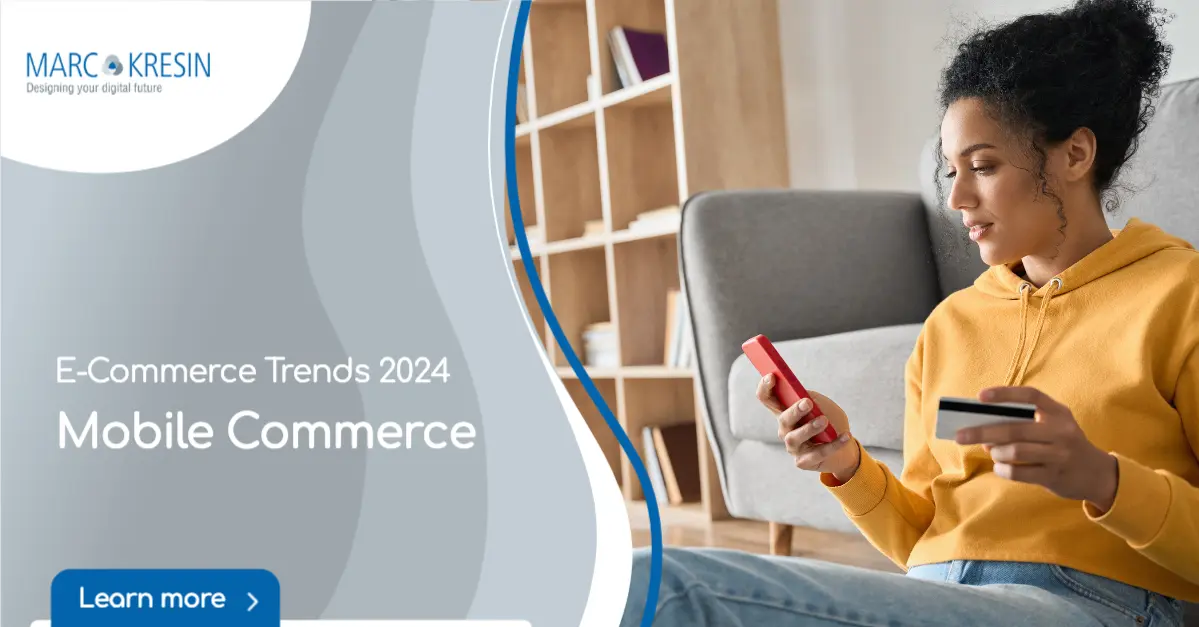
Mobile Commerce Driver of eCommerce Development
The digitization of commerce has profoundly transformed the retail landscape in recent decades. Mobile Commerce, often referred to as M-Commerce, stands out as a significant component of this metamorphosis. In this article, we will delve into Mobile Commerce in detail, explore its significance for consumers and businesses, and take a glimpse into the future of this burgeoning sector.
Summary of Key Mobile Commerce Trends
Mobile Commerce (mCommerce) is undergoing dynamic development, marked by various key trends. In the realm of online shopping, the shift to mobile platforms has seen a significant increase. Users increasingly prefer the convenience of mobile shopping, necessitating optimized user interfaces and personalized shopping experiences.
Mobile payment methods play a central role in mCommerce. The trend is moving towards quick and secure payment options via mobile devices. Mobile wallets are gaining importance as they provide a convenient and secure means of processing payments.
Another significant trend is the integration of Augmented Reality (AR) into mobile shopping applications. Through AR, customers can virtually experience products before purchasing, significantly enhancing the shopping experience and influencing purchase decisions.
The introduction of 5G as a new mobile communication standard contributes to the acceleration of mCommerce. Higher speed and lower latency not only improve overall connectivity but also enable more advanced applications and services in the mobile domain.
Another essential aspect of Mobile Commerce is the extensive generation of data through mobile applications and apps. By analyzing user behavior, businesses can gain valuable insights to specifically enhance their services and products. Data on shopping preferences, dwell time on specific pages, and demographic information enable more precise personalization of offers. This data-driven personalization helps businesses provide tailored recommendations and execute personalized advertising campaigns. However, privacy considerations must be taken into account to maintain customer trust and comply with legal requirements. Overall, data analysis plays a central role in increasing the efficiency and effectiveness of Mobile Commerce strategies and meeting the constantly evolving needs of consumers.
Standalone mobile apps for online shops are gaining further importance. They not only offer a personalized and optimized user experience but also enable companies to interact directly with their customers and provide personalized offers.
In conclusion, Mobile Commerce is characterized by a progressive integration of technologies that positively influence consumer shopping behavior and provide businesses with new opportunities to enhance customer satisfaction and revenues.

What is Mobile Commerce?
Mobile Commerce refers to electronic commerce conducted through mobile devices such as smartphones and tablets. This includes online shopping, bill payment, booking services, and accessing banking services performed through mobile apps or mobile websites. The widespread use of smartphones and the continuous improvement of mobile internet speeds have enabled consumers to conveniently and practically shop online from anywhere and at any time.
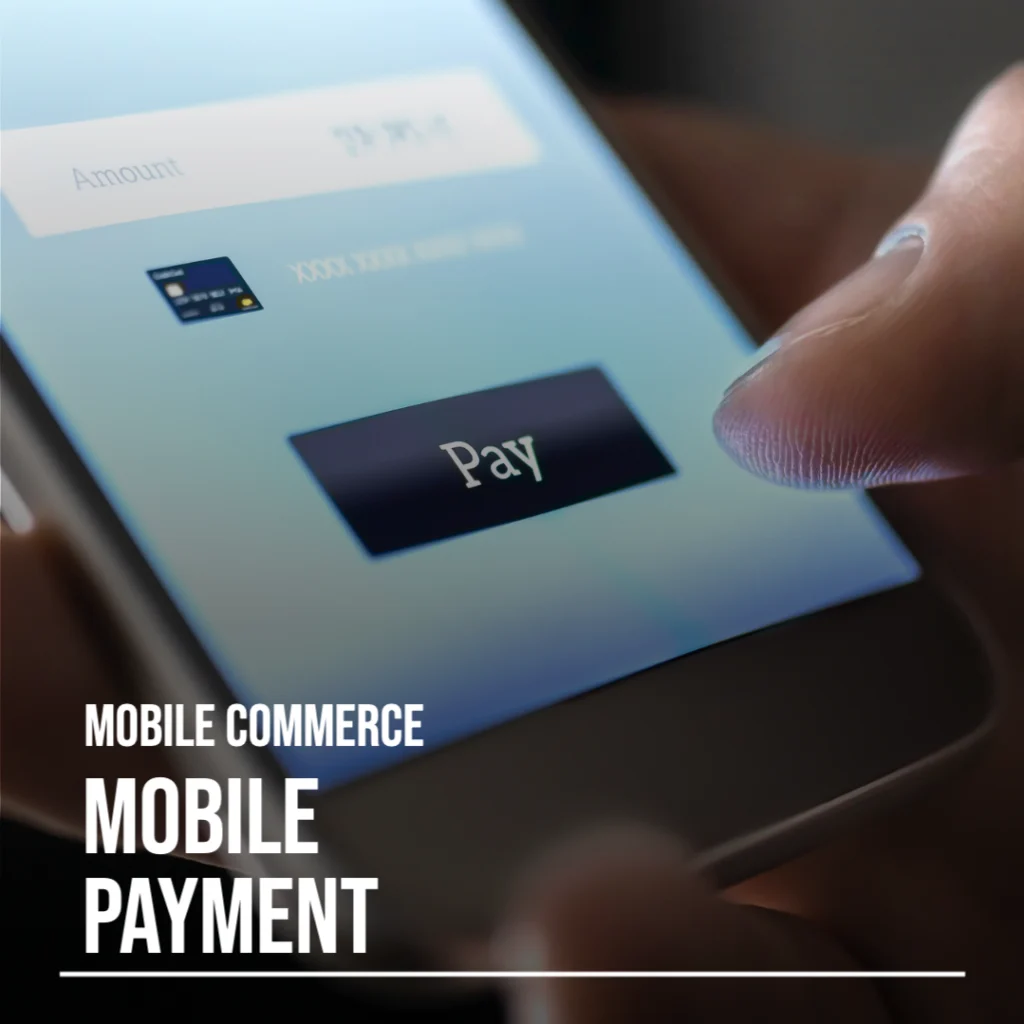
Mobile Commerce in Everyday Life
Mobile Commerce has fundamentally changed the way we shop. Here are some of the most common applications in daily life:
- Online Shopping: With mobile apps from retailers and e-commerce platforms, consumers can conveniently purchase products from their mobile devices. This allows browsing products, reading reviews, comparing prices, and easily placing orders.
- Mobile Payments: Mobile wallets and payment apps like Apple Pay and Google Pay enable users to make contactless purchases. This provides a convenient and secure alternative to cash and credit cards.
- Online Banking: Banking activities can be conveniently carried out through mobile apps. This includes checking account balances, transferring funds, and paying bills.
- Booking Services: Booking services such as flights, hotels, taxis, restaurants, and concert tickets is widespread through mobile apps. This saves time and significantly streamlines the booking process.
- In-Store Experience through Mobile Apps: Retailers like REWE and Lidl utilize apps for customer engagement and insights. Loyalty programs and features like digital shopping lists optimize the shopping experience and provide valuable customer behavior data.
- Omnichannel Shopping: Mobile apps in brick-and-mortar retail strengthen customer loyalty by seamlessly transitioning between online and offline purchases. Companies are increasingly investing in integrating digital technologies to meet the evolving needs of consumers.
Why is Mobile Commerce Successful?
Mobile Commerce has become successful for various reasons:
- Convenience: The ability to shop from anywhere and at any time is a crucial factor in the success of Mobile Commerce. Consumers appreciate the flexibility it offers.
- Personalization: Mobile apps and websites can personalize the shopping experience by providing recommendations based on the customer’s past buying behavior and preferences. This helps enhance customer satisfaction.
- Speed: The entire shopping process, including payment and delivery, can be completed in a short time with mobile devices. This is particularly appealing to consumers with limited time.
- Deals and Discounts: E-commerce companies often offer special deals and discounts for mobile customers to encourage their usage. This can motivate consumers to use mobile apps and make purchases on mobile devices.
- Security: Modern Mobile Commerce platforms prioritize security and data privacy. This has strengthened consumer trust in mobile payment methods.
Revenue and Share of M-Commerce is growing quickly
The significance of mobile commerce in e-commerce is steadily increasing. Both the absolute revenue in e-commerce and the percentage share are growing dynamically. Mobile commerce is developing more dynamically than the overall e-commerce market.
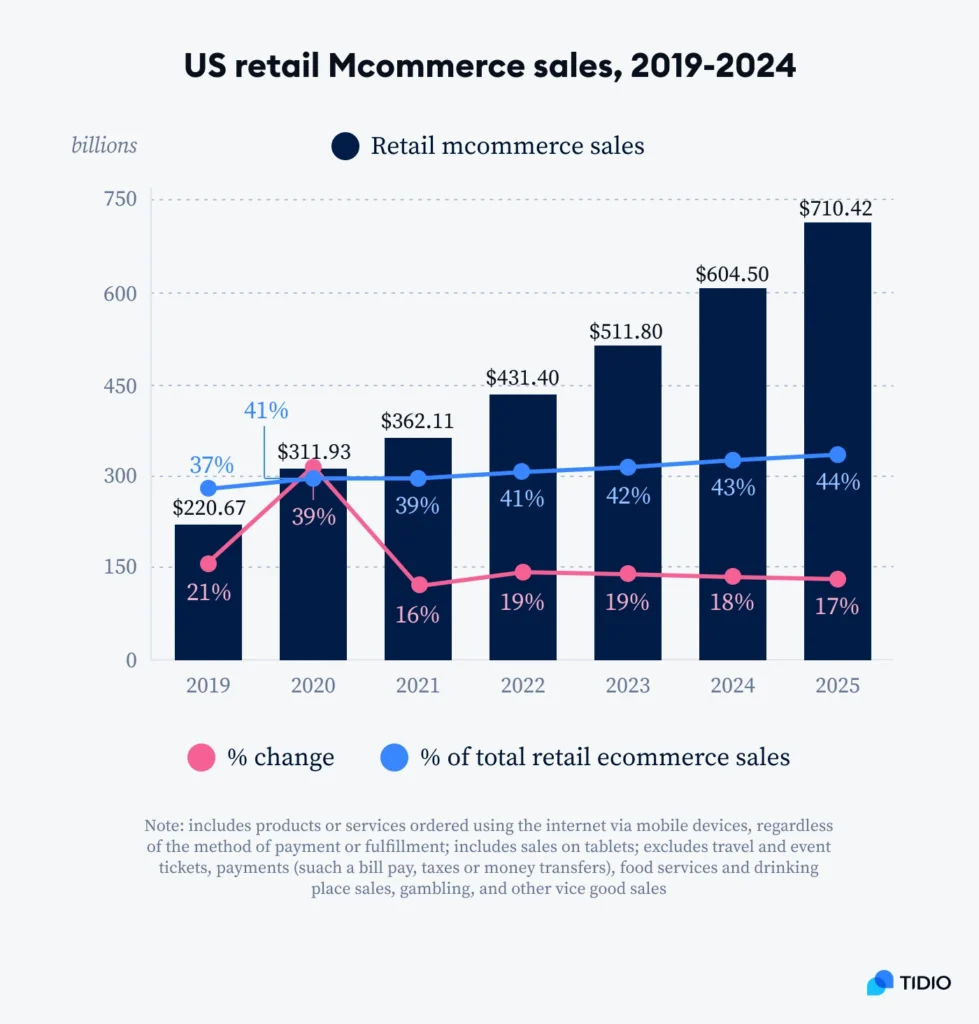
Source: eMarketer Insider Intelligence
Mobile Commerce and Businesses
Mobile Commerce has not only changed consumer shopping behavior but also the business landscape. Companies that do not leverage these developments could miss the potential for a significant market share. Here are some of the impacts of Mobile Commerce on businesses:
- Expanded Reach: By providing mobile apps and websites, businesses can expand their customer base as they are no longer limited to local customers. This allows access to global markets.
- Customer Data and Analytics: Mobile Commerce platforms offer comprehensive insights into customer behavior. Companies can use this data to optimize their products and services and conduct more targeted marketing.
- Customer Engagement: By integrating reward programs and personalized offers into mobile apps, companies can enhance customer engagement. Customers using a mobile app are often more loyal and tend to spend more.
- Efficiency Improvement: Mobile apps can streamline the sales process and reduce operational costs. This leads to higher efficiency and better profitability.
- Competitive Advantage: Companies that effectively harness Mobile Commerce often have a competitive advantage over those that do not. Consumers seek convenient and efficient shopping experiences, and companies providing this can gain market share.
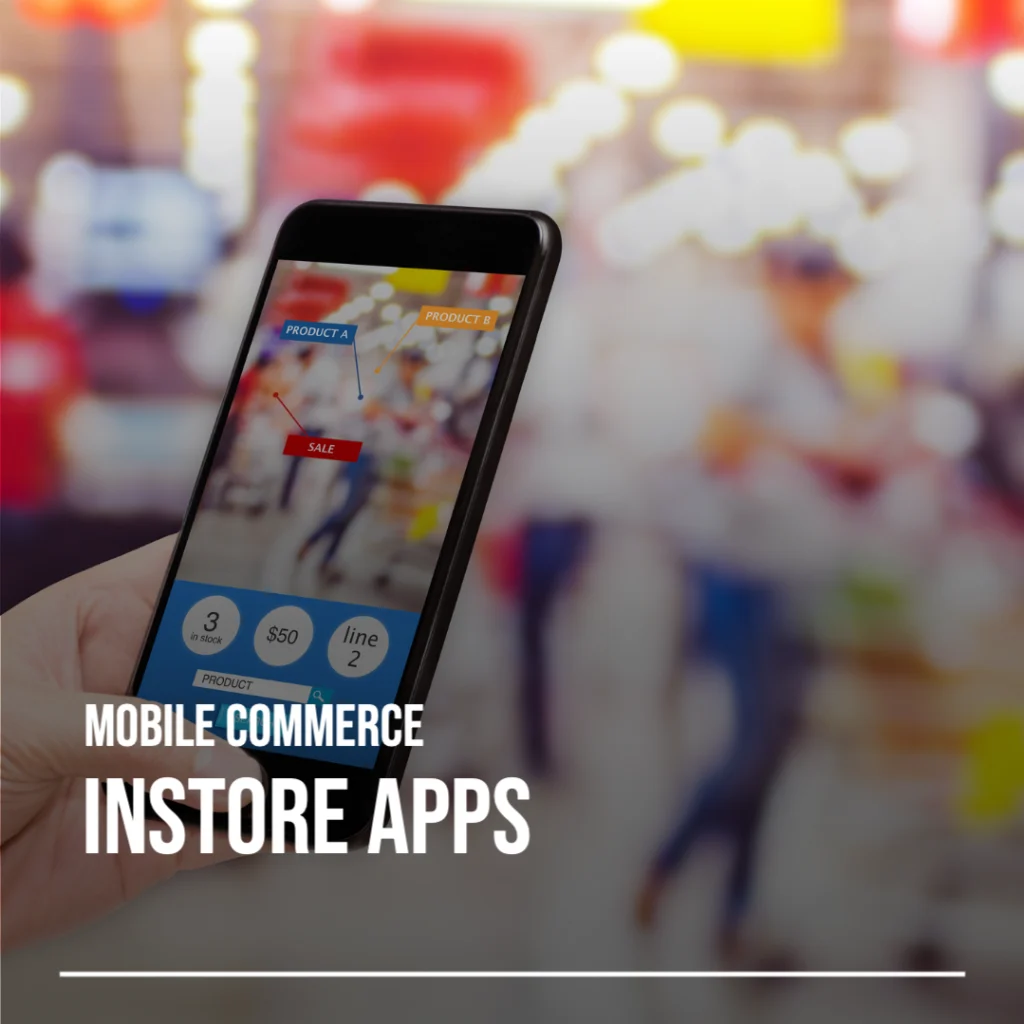
Mobile Apps in Brick-and-Mortar Retail
Mobile apps in brick-and-mortar retail play a crucial role in customer engagement and gaining insights into purchasing behavior and customer needs. Companies like REWE and Lidl have initiated innovative projects to capitalize on these opportunities.
Mobile apps enable retailers to interact directly with their customers and provide personalized offers. By integrating loyalty programs into the apps, customers can be rewarded, fostering brand loyalty. REWE and Lidl rely on such programs to honor loyal customers and offer them exclusive benefits, whether in the form of discounts, special offers, or bonus points.
Furthermore, mobile apps serve as valuable tools for collecting data on customer purchasing behavior and preferences. Analyzing app usage data and transaction histories allows companies to gain insights into individual preferences. This enables targeted personalization of offers and the creation of tailored shopping experiences. Data-driven personalization is crucial for increasing customer engagement and enhancing the relevance of marketing campaigns.
In their app projects, REWE and Lidl have also focused on features that enhance the shopping experience. These include digital shopping lists, location-based offers, and real-time inventory information. These features aim not only to increase customer convenience but also to seamlessly integrate brick-and-mortar retail with the digital world.
It is important to note that the success of such apps is closely tied to customer trust in handling their data. Therefore, companies are increasingly emphasizing transparent data privacy policies and practices to strengthen consumer trust.
In summary, mobile apps in brick-and-mortar retail contribute to tighter customer brand loyalty by providing personalized offers and improved shopping experiences. At the same time, they allow companies to gain valuable insights into customer behavior that can be utilized to optimize product assortments and marketing strategies.
The use of mobile apps in brick-and-mortar retail enables customers to seamlessly switch between online and offline purchases, strengthening customer loyalty and enriching the overall shopping experience. Companies recognize the importance of this trend and are investing heavily in integrating digital technologies to meet the ever-changing needs of consumers.
Development of Mobile Commerce in the Entire E-Commerce Sector
The exact share of Mobile Commerce (mCommerce) in the overall e-commerce market can vary depending on the region, industry, and data source. However, it can be generally stated that the share of mCommerce has been steadily growing in recent years. The increasing use of smartphones and tablets has contributed to consumers increasingly shopping through mobile devices.
In 2022, the global share of mCommerce in the e-commerce market was estimated to be around 50% or more, according to various estimates. These figures underscore the significant impact that mobile devices have on consumer shopping behavior.
Over the past years, the share of mCommerce has steadily increased. This can be attributed to several factors, including the improvement of mobile technologies, the development of user-friendly apps, the rise of mobile payment options, and the overall acceptance and preference for mobile shopping by consumers.
It is important to note that these trends may continue to evolve as new technologies are introduced and user behavior changes. Therefore, regular updates and data analyses are necessary to obtain accurate information about the current state and development of the mCommerce share in the e-commerce market.
The Technical Aspects of Mobile Commerce: A Deeper Examination
Mobile Commerce (mCommerce) has become an integral part of our daily lives, and technological aspects play a crucial role in the success of e-commerce platforms in the mobile environment. In this article, we take a closer look at some key factors, especially Customer Experience, Responsive Design, and Loading Times, and analyze how they influence the conversion rate in mobile shopping.
1. Customer Experience: A seamless and engaging customer experience is essential for success in Mobile Commerce. Navigation through the app or website should be intuitive, and the user interface must be optimized for various screen sizes and device types. This not only builds trust but also ensures that potential customers are guided through the purchase process without frustration.
2. Responsive Design: Responsive design is a key component to ensure that e-commerce platforms display consistently and user-friendly on different devices. Adapting the layout and content to the screen size of the respective device ensures that the user experience remains consistent and engaging. This is particularly important as customers access e-commerce platforms through a variety of devices, from smartphones to tablets.
3. Loading Times: Loading times play a critical role in shaping the customer experience in Mobile Commerce. Studies show that longer loading times can lead to an increased bounce rate. Fast loading times are crucial not only for customer satisfaction but also for search engine optimization (SEO), as search engines like Google prefer mobile pages with fast loading times.
Relationship between Loading Times and Responsive Design with Conversion Rate: The relationship between loading times, responsive design, and the conversion rate is closely intertwined. Mobile users expect fast loading times, and if a page does not load within a few seconds, there is a risk that potential customers will bounce. Effective responsive design ensures that the page not only loads quickly but is also user-friendly and visually appealing, regardless of the device.
Studies have shown that even a one-second delay in loading time can lead to a decrease in the conversion rate. Customers tend to stay on pages with fast loading times and complete the purchase process. Optimal responsive design ensures that content is well displayed on different devices, thereby increasing the likelihood that customers go through the entire purchase process.
Overall, customer experience, responsive design, and loading times are closely interconnected and form the foundation for a successful mobile commerce strategy. E-commerce companies that optimize these technical aspects will not only increase customer satisfaction but also enhance their conversion rates, securing long-term success in the competitive mobile commerce market.
Slow Load Times are killing your conversion rate
The connection is evident and compelling. The longer your online shop or app takes to load, the lower your conversion rate. The most expensive aspect for your online shop is your traffic. And the biggest lever for profitability is your conversion rate. Every tenth of a second costs you a significant amount of money and revenue. This is impressively documented through analysis. 1 second of loading time is the goal. At 2 seconds, the conversion rate is halved. At 3 seconds, it is almost one-third. Optimization in loading times generally provides a strong return on investment.
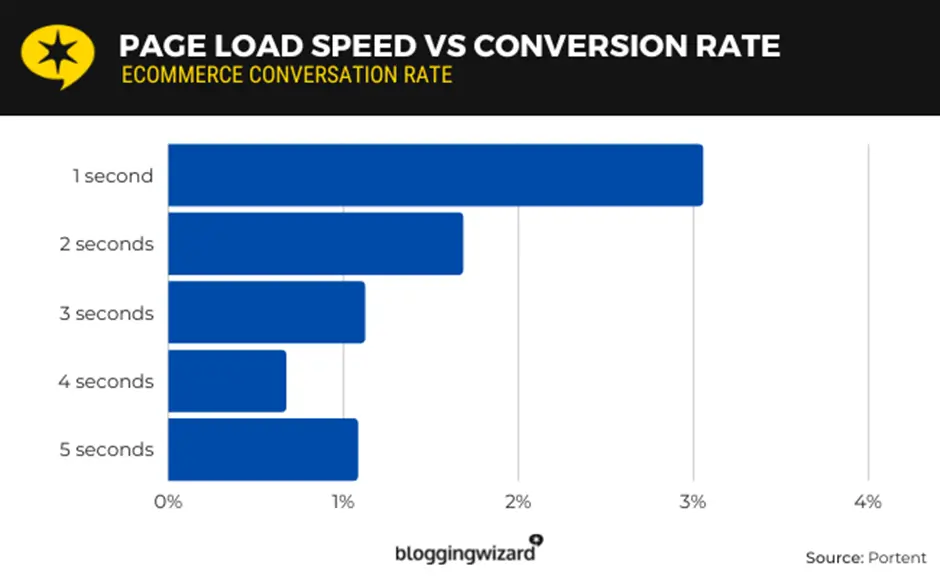
The Future of Mobile Commerce
The future of Mobile Commerce holds promise and is influenced by technological developments, changing consumer preferences, and global trends. Here are some aspects that will shape the future of Mobile Commerce:
- 5G Technology: The expansion of the 5G network will further enhance mobile connectivity and boost the speed and performance of Mobile Commerce applications.
- Augmented Reality (AR) and Virtual Reality (VR): AR and VR technologies have the potential to enrich the shopping experience through virtual try-ons and immersive product presentations.
- Mobile Wallets and Payment Options: New mobile payment options and digital currencies could further change the way transactions are conducted.
Overall, Mobile Commerce has fundamentally changed how we shop and conduct business. The convenience, personalization, and efficiency it offers have made it a crucial part of our modern lives. Companies that leverage the opportunities provided by Mobile Commerce can remain competitive and continue to expand their business. With the continuous evolution of technology and consumer preferences, Mobile Commerce will undoubtedly play a key role in the future of commerce.
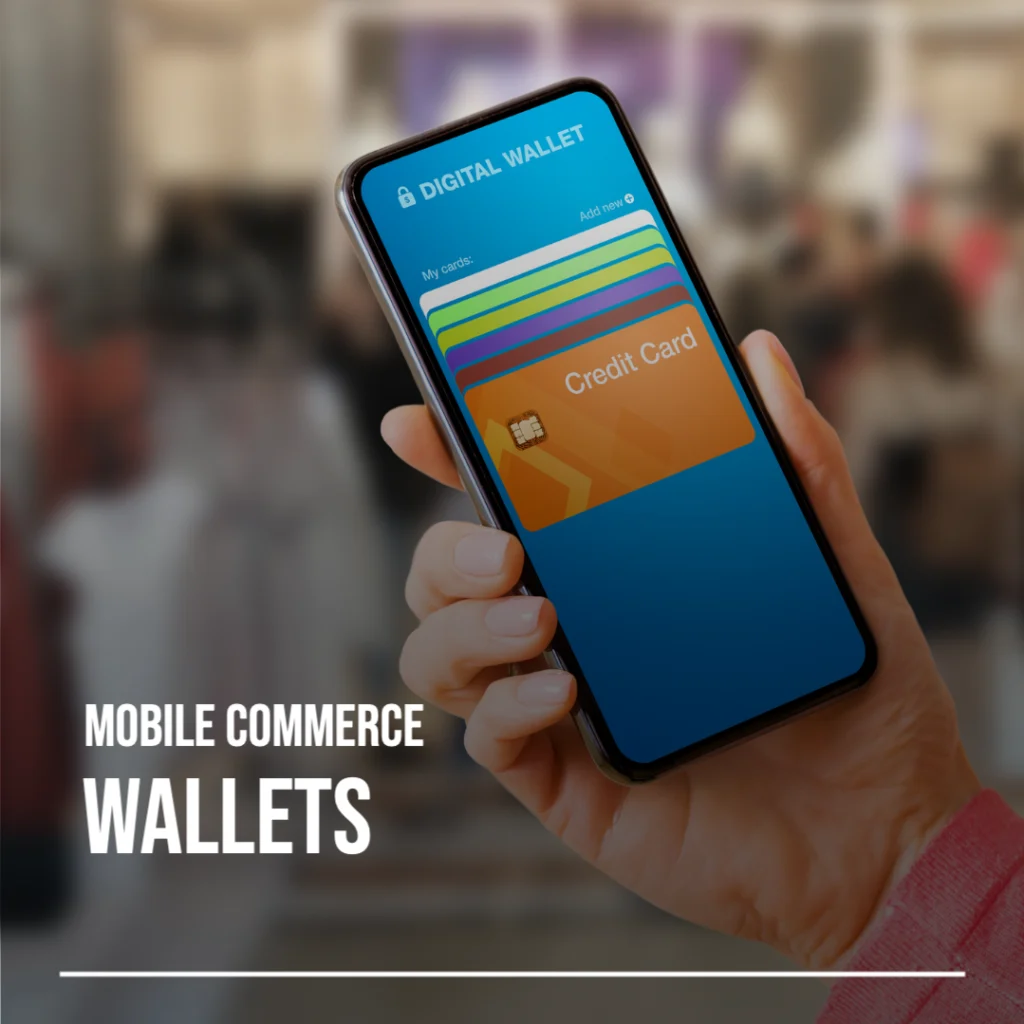
Impact of the 5G Standard on Mobile Commerce
The 5G standard has the potential to enable significant advancements in Mobile Commerce (mCommerce) by introducing new possibilities and improved functionalities. Here are some key aspects of how the 5G standard could influence mCommerce:
- Faster Data Transfer: 5G offers significantly faster data transfer compared to previous mobile standards. This higher bandwidth allows for quicker downloads of content, larger data volumes, and smoother streaming services. In mCommerce, this could lead to faster loading times for product images, videos, and other multimedia content, significantly enhancing the user experience.
- Low Latency: The low latency of 5G enables real-time interactions and transactions. This could revolutionize the use of Augmented Reality (AR) and Virtual Reality (VR) in mCommerce. Customers could virtually try out products or receive real-time personalized offers, leading to a more interactive and engaging shopping experience.
- Improved Connectivity in Crowded Areas: In densely populated urban areas where mobile networks are often overloaded, 5G could provide more stable and reliable connectivity. This is particularly important for mCommerce applications to ensure that customers have a smooth shopping experience even in heavily frequented areas.
- Internet of Things (IoT) in E-Commerce: 5G enables reliable connectivity of devices in the Internet of Things (IoT). In mCommerce, smart devices could be seamlessly integrated into the shopping process. For example, smart shelves in retail could automatically update inventory data, leading to more efficient supply chains and improved inventory management.
- Personalized Location Services: By combining 5G with precise location services, mCommerce platforms could provide personalized offers based on the user’s current location. This could allow retailers to offer location-based promotions and advertisements to strengthen customer loyalty.
- Enhanced Security for Mobile Payment: The higher security and reliability of 5G could make mobile payment transactions more secure. This could potentially reduce concerns regarding the security of transactions in mCommerce and further promote the acceptance of mobile payment methods.
Overall, the 5G standard opens up new horizons in Mobile Commerce by transforming how users interact and shop through mobile applications. The improved connectivity, low latency, and increased bandwidth create an environment for innovative applications that can fundamentally change the consumer shopping experience.
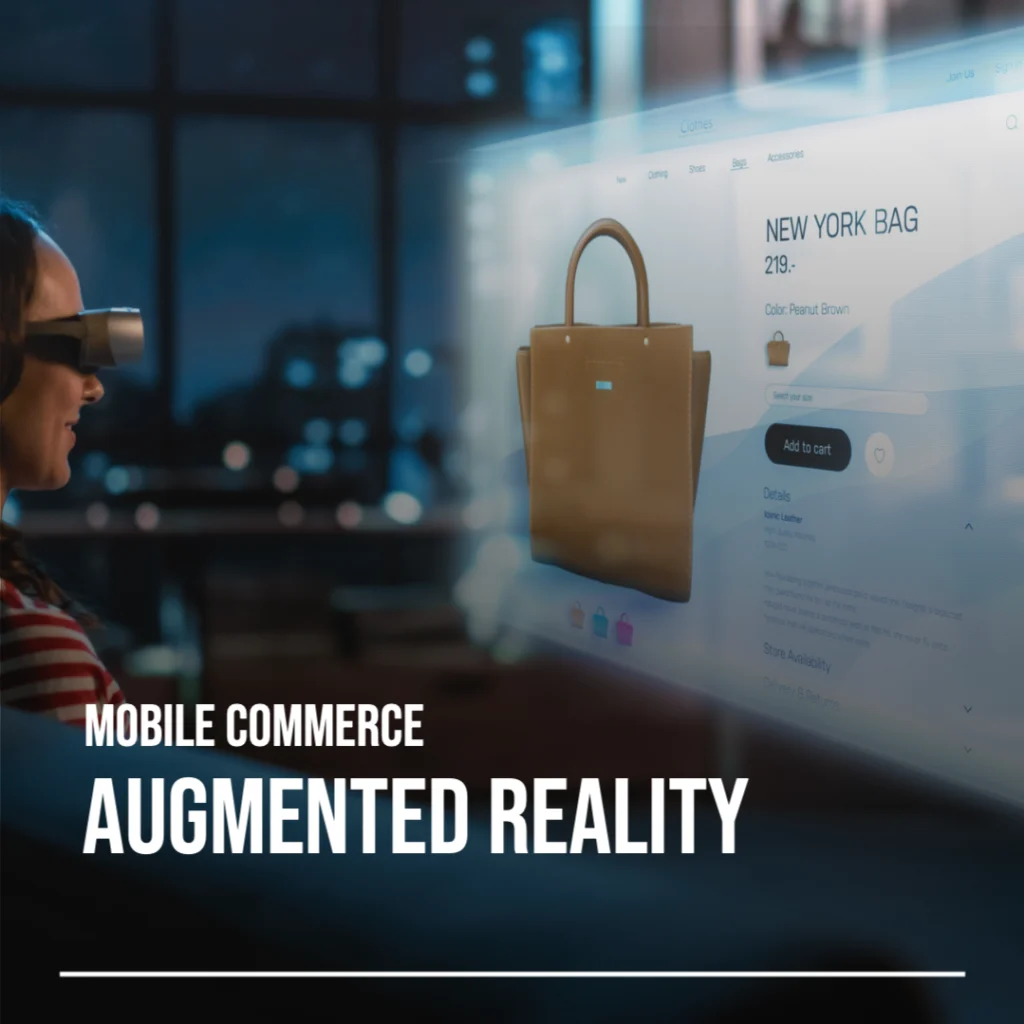
New Opportunities through Augmented Reality / Virtual Reality in Mobile Commerce
The integration of Augmented Reality (AR) and Virtual Reality (VR) in Mobile Commerce (mCommerce) has the potential to fundamentally transform the shopping experience. Here are some of the changes that AR and VR could bring to mCommerce:
1.Virtual Product Try-Ons: AR allows customers to virtually try out products before making a purchase. For example, customers can use AR apps to try on clothing virtually or project furniture into their own living spaces. This interactive feature increases the confidence in purchasing decisions and reduces the risk of returns.
2.Personalized Shopping Experiences: AR and VR enable personalized shopping experiences by customizing offers and product presentations based on individual preferences and needs. Using AR, retailers can offer personalized promotions based on users’ purchase histories and preferences.
3.Virtual Product Presentations: VR provides the ability to create immersive virtual product presentations. Customers can explore and experience products in a digital space as if they were physically present. This is particularly relevant for industries such as real estate, automotive, and tourism, where customers want to comprehensively explore complex products before making a purchase.
4.Enhanced In-Store Navigation: AR can improve navigation in physical stores. By using AR on mobile devices, customers can, for example, search for specific products in a store and receive real-time information on product locations, offers, and reviews.
5.Virtual Shopping Communities: VR can create virtual shopping communities where customers can meet, interact, and shop together. This introduces a social element to online shopping, recreating the sense of communal shopping inherent in traditional retail experiences.
6.Improved Training and Product Information: AR can be used for training purposes and providing detailed product information. Customers can receive additional information about products using AR elements, including usage instructions or detailed technical data.
7. Better Integration of VR into Mobile Commerce Apps: Integrating VR features directly into Mobile Commerce apps creates a seamless and convenient way for customers to experience VR. This could help increase the acceptance of VR in the shopping realm, making it more accessible to customers.
Overall, AR and VR in Mobile Commerce offer a myriad of opportunities to make the shopping experience more interactive, personalized, and engaging. Retailers that adeptly employ these technologies can not only increase customer satisfaction but also strengthen their competitive position in the ever-changing retail market.
Summary of Mobile Commerce
Mobile Commerce (mCommerce) has revolutionized commerce, shaped by various trends such as mobile online shopping, mobile payment, and the integration of Augmented Reality. The advent of 5G brings new possibilities with faster data transfer and low latency. Technical aspects like Customer Experience, Responsive Design, and loading times influence the conversion rate. Data analysis plays a central role, while mobile apps in brick-and-mortar retail enhance customer loyalty. The mCommerce share of E-Commerce continues to grow, and the future promises innovations through 5G, AR/VR, and new payment options. The impact of AR and VR in mCommerce allows virtual product try-ons, personalized shopping experiences, and improved in-store navigation. Overall, Mobile Commerce fundamentally reshapes the way we shop and continues to advance through technological developments.
Recommendations for Success in Mobile Commerce
Recommendations for companies in Mobile Commerce:
1. Optimize Mobile Apps and Websites:
- Ensure your mobile apps and websites offer user-friendly and intuitive navigation.
- Optimize the user interface for various screen sizes and device types.
- Implement responsive design to ensure consistent display on different devices.
2.Ensure Fast Loading Times:
- Invest in optimizing the loading times of your mobile apps and websites.
- Fast loading times contribute to increased customer satisfaction and improved conversion rates.
3.Introduce Mobile Wallets and Payment Options:
- Offer various mobile payment options, including mobile wallets, to meet customer needs for fast and secure transactions.
4. Integration of Augmented Reality (AR):
- Consider integrating AR into your Mobile Commerce applications to enable virtual product try-ons.
- Utilize AR for personalized shopping experiences and enhanced product presentations.
5. Utilize 5G Technology:
- Consider implementing features benefiting from the higher bandwidth and lower latency of 5G.
- Explore the integration of real-time interactions and personalized offers enabled by 5G.
6. Data-Driven Personalization:
- Leverage extensive data analysis to understand user behavior and create personalized offers.
- Pay attention to privacy aspects and ensure customer trust through transparent privacy policies.
7.Investment in Mobile Apps in Brick-and-Mortar Retail:
- Develop standalone mobile apps for brick-and-mortar retail to strengthen customer loyalty.
- Integrate features such as digital shopping lists, location-based offers, and real-time inventory information.
8.Regular Updates and Adjustments:
- Stay updated on technological developments in Mobile Commerce.
- Implement regular updates to adapt to changing consumer preferences and new technologies.
9.Strengthen Security Measures for Mobile Payment:
- Implement enhanced security protocols for mobile payment transactions to strengthen customer trust.
- Educate customers about security measures to reduce concerns regarding mobile payment methods.
10. Focus on Innovation and Customer Experience:
- Stay innovative and continuously offer new features to enhance the customer experience.
- Ensure your Mobile Commerce offering keeps pace with evolving consumer needs.
By implementing these recommendations, companies can strengthen their position in Mobile Commerce, increase customer satisfaction, and remain competitive in an ever-evolving digital commerce landscape.
Sources:
- https://www.chip.de/news/Rewe-stellt-langjaehrigen-Service-ein-Kunden-muessen-sich-umstellen_184360970.html
- https://www.giga.de/p/lidl-plus/
- https://www.mordorintelligence.com/de/industry-reports/m-commerce-market
- https://de.statista.com/themen/1347/mobile-commerce/#topicOverview
- https://kinsta.com/de/mobile-vs-desktop-marktanteil/
- https://capturly.com/blog/website-page-load-statistics-you-need-to-know-that-impacts-the-conversion-rate/
- https://www.oberlo.de/blog/umsatz-im-mobilen-e-commerce
- https://www.e-commerce-magazin.de/e-commerce-umsaetze-deutlicher-einbruch-fuer-2023-erwartet/
- https://www.asendia.de/asendia-insights/e-commerce-trends-2023-im-r%C3%BCckblick
- https://www.tidio.com/blog/mobile-commerce-statistics/
- https://capturly.com/blog/website-page-load-statistics-you-need-to-know-that-impacts-the-conversion-rate/
Further contributions on the topic
Competitive advantages through personalization & AI in eCommerce
Create competitive advantages through personalization & artificial intelligence in eCommerce The personalization in e-commerce focuses on meeting the needs and preferences of individual customers by
Mobile Commerce: Driver of E-Commerce
Mobile Commerce Driver of eCommerce Development The digitization of commerce has profoundly transformed the retail landscape in recent decades. Mobile Commerce, often referred to as
